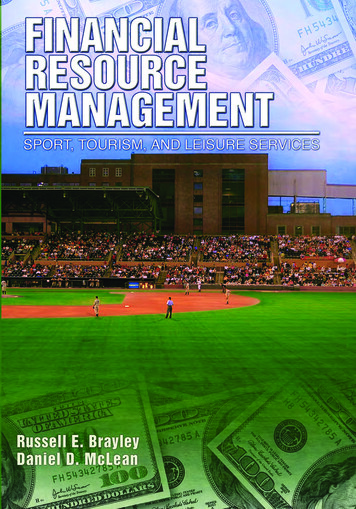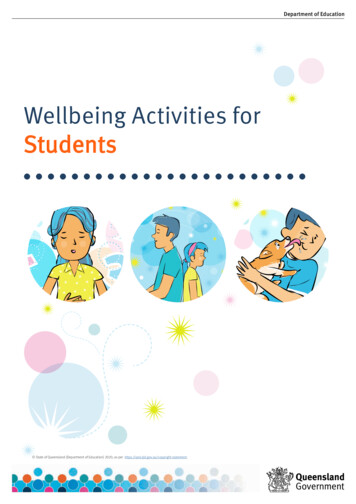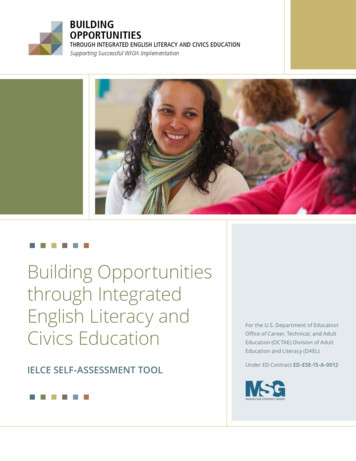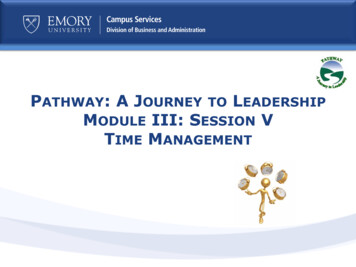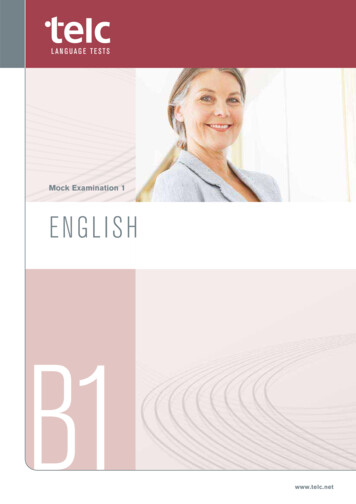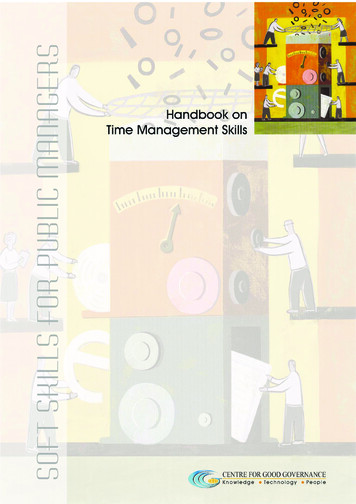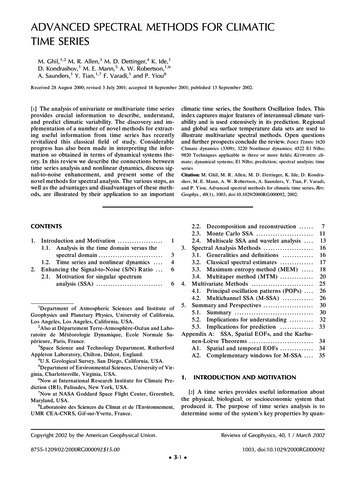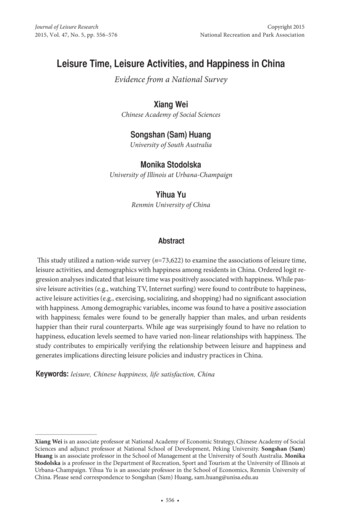
Transcription
Journal of Leisure Research2015, Vol. 47, No. 5, pp. 556–576Copyright 2015National Recreation and Park AssociationLeisure Time, Leisure Activities, and Happiness in ChinaEvidence from a National SurveyXiang WeiChinese Academy of Social SciencesSongshan (Sam) HuangUniversity of South AustraliaMonika StodolskaUniversity of Illinois at Urbana-ChampaignYihua YuRenmin University of ChinaAbstractThis study utilized a nation-wide survey (n 73,622) to examine the associations of leisure time,leisure activities, and demographics with happiness among residents in China. Ordered logit regression analyses indicated that leisure time was positively associated with happiness. While passive leisure activities (e.g., watching TV, Internet surfing) were found to contribute to happiness,active leisure activities (e.g., exercising, socializing, and shopping) had no significant associationwith happiness. Among demographic variables, income was found to have a positive associationwith happiness; females were found to be generally happier than males, and urban residentshappier than their rural counterparts. While age was surprisingly found to have no relation tohappiness, education levels seemed to have varied non-linear relationships with happiness. Thestudy contributes to empirically verifying the relationship between leisure and happiness andgenerates implications directing leisure policies and industry practices in China.Keywords: leisure, Chinese happiness, life satisfaction, ChinaXiang Wei is an associate professor at National Academy of Economic Strategy, Chinese Academy of SocialSciences and adjunct professor at National School of Development, Peking University. Songshan (Sam)Huang is an associate professor in the School of Management at the University of South Australia. MonikaStodolska is a professor in the Department of Recreation, Sport and Tourism at the University of Illinois atUrbana-Champaign. Yihua Yu is an associate professor in the School of Economics, Renmin University ofChina. Please send correspondence to Songshan (Sam) Huang, sam.huang@unisa.edu.au 556
Leisure and Happiness in China 557IntroductionThis paper aims to examine the associations of leisure time, leisure activities, and relevantdemographic variables with happiness among residents in China. Although some research hasbeen conducted to investigate how leisure affects Chinese people’s well-being (Lau, Cummins,& McPherson, 2005; Lu & Hu, 2005; Spiers & Walker, 2009; Vong, 2005), most of the previousstudies in this regard focused on residents in Hong Kong, Macao, and Taiwan who are facingrelatively different social realities and environments compared to mainland Chinese residents.Some researchers (e.g., Jim & Chen, 2009; Lee & Zhang, 2010; Liu, 2006) studied residents inspecific mainland Chinese cities; with relatively small samples of less than 1,000, existing studiesare limited in presenting a national profile. A review of the literature has not revealed any studythat investigated the national profile of how leisure is related to happiness of mainland Chineseresidents. In the current study, we utilized data from a nationwide survey jointly implemented bythe China National Bureau of Statistics (CNBS), the General Post Office of China (GPOC), andthe China Central Television (CCTV), and ran a thorough analysis on the relationships betweenleisure, relevant demographics and mainland Chinese residents’ self-reported happiness.China has become the second largest economy in the world. In 2011, China’s gross domesticproduct (GDP) reached US 7.298 trillion and its population was 1.344 billion, accounting forapproximately one fifth of the world’s population (World Bank, 2011). Since the 1980s, China’sannual economic growth rate has seen an average of above 9%, well above the 2.3% growth rate indeveloped economies (World Bank, 2011). As a consequence of its rapid economic development,living standards of people in China have been greatly improved (Zhou, Li, Xue, & Lei, 2012).In the meantime, mainland Chinese residents not only have the adequate financial resourcesto participate in leisure activities, they also have enough time to do so (Liang & Walker, 2011).In the literature, a positive relationship between leisure and happiness has been well supported (Bailey & Fernando, 2012; Crandall, 1980; Heo, Lee, Kim, & Chun, 2012; Ragheb & Tate,1993; Spiers & Walker, 2009). However, as most of the studies confirming such a relationshipwere conducted in the context of western developed countries, it is necessary to test whethersuch a relationship holds in contemporary China whereby a unique economic and social development stage is witnessed. It is commonly conceived that China’s transition from socialism tocapitalism brings greater happiness to its nationals, as personal income will be raised by a moreefficient allocation of resources and increased incentives for private investment (Easterlin, Morgan, Switek, & Fei, 2012). Also, in such a transition period, residents in China have witnesseda significant increase of leisure time (Yin, 2005) as well as leisure consumption (Zhai & Xiao,2004). Therefore, it is reasonable to postulate that leisure would be a significant factor that informs people’s happiness in the rapid transition of the modern Chinese society. As such, Chinarepresents a most desirable context to further test the leisure-happiness relationship. Most ofthe existing conceptualizations on how leisure is associated with happiness have been derivedfrom the Western cultural contexts (Iwasaki, 2006; Spiers & Walker, 2009). Therefore, the currentstudy is hoped to contribute to the literature by examining the relationship between leisure andhappiness in the context of China.Literature ReviewHappiness and Chinese HappinessInterest in happiness has become a global phenomenon, and the ability to be happy is a central criterion of positive life (Lyubomirsky, Sheldon, & Schkade, 2005). Happiness means good
558 Wei, Huang, Stodolska, and Yulife that can be examined with both cognitive (e.g., Quality of Life, QOL) and affective (e.g., Subjective well-being, SWB) aspects (Spiers & Walker, 2009). Although there are subtle differencesbetween SWB and QOL, the two aspects could be used as interchangeable measures for overallfeeling of happiness (Easterlin, 2004). In the present study, SWB is treated as a suitable proxy forhappiness. As demonstrated in the literature, direct reporting of SWB may have a useful role inthe measurement of consumer preferences and social welfare (Kahneman & Krueger, 2006). Inthis study, the self-reported measure for happiness is used in a large-scale questionnaire survey.The literature on happiness is equally mixed with economists’ and psychologists’ perspectives. Most economists place particular emphasis on the importance of income and employmentsituation to happiness and, at the extreme, this view tends to employ real GDP per capita asa measure of well-being (Fuchs, 1983, p. 14). However, Easterlin (1974) documented stagnantaverage happiness levels in the United States even with large income increases. After that, someother empirical studies provided further evidence in support of the above finding in a numberof countries (Blanchflower & Oswald, 2011; Easterlin, 1995, 2005). Across the research camps,the finding explored by economists was somewhat fully explained by psychologists who typicallyview the impact of material conditions on well-being as being adjusted by “adaptation processes”(Oswald & Powdthavee, 2008). At the extreme, this process led to the notion “effect of hedonictreadmill” (Kahneman, 1999, p. 13), meaning that good and bad events temporarily influencehappiness, but people can quickly adapt back to the neutral state of their hedonic feeling. Thisview is also typically formulated as the “set-point model” in which “each individual is thoughtto have a fixed setpoint of happiness determined by genetics and personality; life events such asmarriage or divorce, job loss, or serious injury or disease may temporarily deflect a person aboveor below this setpoint, but in time each individual will adjust to the new circumstances and return to the given setpoint” (Easterlin, 2004, pp. 26–27).Happiness research in psychology has a profound impact on happiness research in economics. It revealed that the policies to maximize a society’s welfare should pay more attention toincreasing social contacts than to increasing consumption opportunities (Layard, 2005). Moreover, adaptation in SWB reminded that people should shift their attention from an emphasis onthe importance of income to an emphasis on the importance of people’s social status (Kahneman& Krueger, 2006).There have been quite a number of recent studies on Chinese people’s SWB or happiness.Liu (2006) indicated that Chinese people’s perceptions of QOL are mainly around five important life domains: health, family, work, social relations and the natural environment. Lu (2001),after investigating Chinese conceptualizations of happiness, added that Chinese happiness canbe understood from three different philosophical perspectives: Confucianism, Taoism, and Buddhism. While Confucianism sees happiness to be in constant self-cultivation to achieve moralgreatness, Taoism regards happiness to be derived from following “Tao,” the Great Natural Force,and personal liberation from human desires. Happiness in Buddhism can only be found in theother world after “nirvana,” imbued with eternal bliss beyond everyday misery of this world (Lu,2001). Burkholder’s (2005) study based on a Gallup survey found that Chinese happiness almostremained constant in recent decades; similar findings were disclosed by Crabtree and Wu (2011)and Easterlin et al. (2012). On the other hand, the think tank organization PEW Research Centre (2011) revealed that Chinese nationals experienced rising life satisfaction along with risingincomes. In a cross-sectional study, Lee (2005) studied 109 randomly selected Chinese peopleaged 60 in Hong Kong and mainland China, and found that mental health status, number of daysstaying in hospital, life satisfaction, age, and self-esteem were significant factors predicting theseelderly Chinese people’s happiness.
Leisure and Happiness in China 559Recently, Easterlin and his colleagues (2012) found that China experienced a U-shape pattern of life satisfaction from 1990 to 2010. They further concluded that life satisfaction in Chinahas declined remarkably among the lowest income and least educated segments of the population; however, rising life satisfaction was found among the upper socioeconomic stratum. Research on Chinese people’s subjective well-being (SWB) has found that among different samples,SWB was found to be positively correlated with income, good health, being married, femaleand a Community Party member (Appleton & Song, 2008; Monk-Turner & Turner, 2012). In arecent study, Sun et al. (2015) found that among a national sample of 8,000 Chinese respondents,SWB increased with levels of subjective health, income and education, but was lowered amongunemployed and divorced individuals. However, after controlling for socioeconomic characteristics and subjective health status, SWB was also found to be higher in rural areas than urbanareas in the same region. However, whether there is a rural-urban divide of Chinese happinessis not clear. Davey, Chen and Lau (2009)’s study on a sample of Chinese peasants living in aremote farming village found that despite the respondents’ relatively low socioeconomic conditions, their reported life satisfaction levels were still within the normative range for the Chinesepopulation.With intensifying income inequality in China, some researchers have attended to studying the relationship between inequality and happiness (Jiang, Lu, & Sato, 2012; Smyth & Qian,2008). Smyth and Qian found that high income individuals who perceive unequal income distribution reported higher levels of happiness while low income individuals who perceive incomeinequality report lower levels of happiness. Zhu and Xie’s (2015) analysis on the survey data in60 counties of China from 2005 to 2010 revealed that Chinese people’s life satisfaction does notvary much with regional differences in economic development but closely relates to temporalchanges of local level economic development over time. In summary, the current research onChinese happiness acknowledged that socioeconomic variables are closely associated with happiness; however, with the fast social and economic changes in China, Chinese people’s happinessas determined by temporal changes need to be further addressed. Particularly, social life changessuch as the increased leisure time and leisure activities among Chinese nationals need to be examined in explaining Chinese happiness.The Role of Leisure in HappinessThe relationship between leisure and happiness has been extensively studied. Spiers andWalker’s study demonstrated that lasting happiness was influenced by involvement in leisureactivities that produce flow experiences (Csikszentmihalyi, 1975; Diene, 2000). It is believedthat leisure activity, as an antecedent of leisure satisfaction (Ragheb & Tate, 1993) can also become the best predictor of happiness (Spiers & Walker, 2009). However, a study on 8,000 Dutchrespondents indicated that there was no causal relationship between leisure exercise and happiness, despite that exercise participation was associated with higher levels of happiness (Stubbe,de Moor, Boomsma, & de Geus, 2007). Other researchers (e.g., Rojas, 2006) also question thatthe causal relationship between leisure exercise and happiness may not be valid.Many research studies supported the positive relationship between leisure and happiness.Lu and Argyle (1994) found that leisure satisfaction is correlated with happiness, and socialaspects of leisure satisfaction predicted happiness on a longitudinal basis. Leisure activities werefound to be a major source of happiness (Hills & Argyle, 1998, Lloyd & Auld, 2002). For example,church activities were found to produce resonating emotions, often accompanied by feelingsof great joy; these activities seem to be an important determinant of well-being, especially forelderly people (Hills & Argyle, 1998). Hills and Argyle also noted that given the available leisure
560 Wei, Huang, Stodolska, and Yuactivities, individuals’ personality might influence personal choice in leisure, and then affect thedegree of happiness. This view is consistent with Kahneman’s theory of “hedonic adaptations,”which stresses that individual happiness is determined primarily by personality and genetics.Sakkthivel (2011) disclosed that nonmonetary leisure behavioral styles (e.g., reading novels,watching television, outdoor game, cycling, fishing) provided higher happiness than monetaryleisure behavioral styles (e.g., visiting entertainment centers, visiting night clubs, visiting casinos, scuba diving). Studies have found that when controlling for demographic variables (e.g.,employment, social class, and gender), a strong correlation between leisure satisfaction and happiness is evident (Ateca-Amestoy, Serrano-Del-Rosal, Vera-Toscano 2004; Van Praag & Ferreri-Carbonell, 2004). Generally speaking, leisure plays a significant role in affecting individualhappiness (Wang & Wong, 2011).Bonke, Deding, and Lausten’s (2009) work provided more insights in understanding therelationship between leisure and happiness. Firstly, they noted that leisure satisfaction dependedon both the quality and quantity of leisure. The quality of leisure is reflected on two dimensions:good intensiveness and social intensiveness. The good intensiveness of leisure is expressed by expenditures on leisure goods (e.g., sports equipment or hobby items), while the social intensiveness of leisure can be shown by the number of family members and friends and social activities.Empirical evidence showed that good intensiveness is more important for men, while socialintensiveness is more important for women (Bonke et al., 2009). Secondly, holding the traditional theory of economic well-being, Bonke et al. assume that income and leisure time are themain sources of utility for well-being. They further argue that while money (income) and time(leisure) can be substitutes to each other, satisfactions with these two domains are seeminglycomplementary. To enjoy income, one has to have free leisure time; and to enjoy leisure, moneyfor leisure activities is needed. Therefore, income and leisure should be considered together asdeterminants to happiness. Thirdly, they found that intra-household effects and individual characteristics mattered more for women than men for both economic and leisure satisfactions.There also exists other empirical evidence to support intra-household effects on well-being.For instance, Burton and Phipps (2007) examined the association between children’s well-beingand parents’ leisure time spared with children in the UK, the US, Canada, Germany, and Sweden.They found that children’s well-being could be reduced due to their parents’ effort to increasework hours to generate more money.In summary, the literature suggests a well-established relationship between leisure satisfaction and happiness. On such a basis, we proposed both leisure time and leisure activities wouldbe significantly related to people’s happiness in China.Chinese Leisure and HappinessThere has been little research examining the relationship between leisure and happiness inChinese contexts. A few studies, however, focused on overseas Chinese or Chinese residents inHong Kong, Macao or Taiwan. Spiers and Walker (2009) examined how ethnicity and leisure satisfaction are related to happiness among Chinese Canadians and British Canadians. They foundthat ethnicity is significantly associated with standard of living, life achievement and life as awhole. In addition, overall leisure satisfaction significantly affected happiness; and happinessand personal relationships were positively correlated for some Chinese Canadians. In a studyof university students in Taiwan, Lu and Hu (2002) found that leisure had short-term benefits,which include positive mood, physical fitness and better structuring of time, as well as long-termeffect on happiness. In a later study, Lu and Hu (2005) examined the relationships among per-
Leisure and Happiness in China 561sonality, leisure involvement, leisure satisfaction and happiness. The study findings revealed that1) neuroticism was not correlated to leisure activities, 2) extraversion was positively correlatedwith leisure satisfaction, and 3) leisure satisfaction had incremental effect on happiness. Similarly, Vong (2005) studied Chinese residents in Macao and found a positive correlation betweenleisure satisfaction and emotional well-being.In summary, the literature informs that leisure is associated with happiness, and happinessvaries with different demographic variable (e.g., gender, age, income). However, in the contextof contemporary China, the relationships between leisure, demographics and happiness may besubject to both cultural and societal influences. Leisure time is needed for people to enjoy leisureactivities. However, under the influence of the Confucian tradition, people may prefer the quality of leisure time to the amount of leisure time they have (having too much leisure time or idlingis not appreciated in a Confucian culture). Therefore, leisure time may serve as a necessary condition for performing leisure activities that will eventually affect happiness; but its incrementalvalue may be limited. Similarly, people in China may see values associated with different leisureactivities differently based on their cultural preferences. Hence, some leisure activities may beassociated with happiness more than others. From a social policy making perspective, it is important to know which leisure activities leverage happiness. In China’s fast social and economictransformation, different social groups may face different social expectations and living pressure,the current social milieu may determine some demographic variables to be more prominentthan others in explaining happiness. For instance, as ostentation appears a prevalent social phenomenon in China, the association between income and happiness in China is expected to bemore significant than that in other countries. To further clarify the relationship between leisureand happiness and that between demographics and happiness in China, the following specificresearch questions are formulated in the current study:RQ1: How is leisure time related to happiness in contemporary China?RQ2: How are different leisure activities associated with happiness in contemporaryChina?RQ3: What are the relationships between sociodemographic characteristics and happiness in contemporary China?MethodsData CollectionData for this study came from the Survey of the Chinese Economic Life (SCEL). SCEL isan annual national survey jointly conducted by the China Central Television (CCTV), the China National Bureau of Statistics (CNBS) and the General Post Office of China (GPOC). In theimplementation of the SCEL survey, CCTV is in charge of promoting and releasing the results;GPOC is responsible for delivering and collecting returned questionnaires through the nationalpost system, whereas CNBS takes charge of coding and data screening. The Survey has been inoperation since 2006. All respondents of the SCEL are residents in mainland China. We sourcedour data from the 2011 SCEL survey.The 2011 SCEL survey was administered through the General Post Office of China (GPOC).The GPOC is the central post authority in charge of the national post system in China. The SCELquestionnaire was printed on postcards with prepaid return postage. GPOC appointed specialpostal employees to distribute the SCEL postcard questionnaires.
562 Wei, Huang, Stodolska, and YuThe 2011 SCEL survey data were collected from all 31 provinces, autonomous regions, andmunicipalities of Mainland China from May 2011 to February 2012. A total of 100,000 questionnaires were distributed across Mainland China by local postal employees. Each city/village postoffice was given a certain number of questionnaires based on the population of the area; post delivery staff randomly delivered the postcards questionnaires to the households by using methodslike delivering a postcard to every ith household in a street. In order to minimize omissions, improperly completed surveys, and to overcome the problem of limited literacy, postal employeesrecorded the responses to the survey. The postmen were then responsible for mailing the surveysto the Computing Center of CNBS. This process yielded 73,622 complete questionnaires with avalid response rate of 73.6%.MeasurementsIn the 2011 survey, two questions about leisure time and leisure activities were added inthe questionnaire, enabling the examination of the effect of leisure time and leisure activitieson Chinese people’s happiness. The questionnaire comprises two sections. Section One includes14 questions, three of which referred to leisure time, leisure activity, and subjective well-being(SWB), respectively. The SWB measure was deemed a suitable proxy to happiness in the currentstudy. Section Two consists of question items collecting demographic information of the respondents, including age, gender, household income, education, residence identity, and maritalstatus.The question measuring leisure time was: “How much leisure time (except for sleeping,schooling, and eating) on average per day do you have in 2011?” Discrete answer options tothis question ranged from “none,” “less than 1 hour,” “1-2 hours,” “2-3 hours,” “3-4 hours,” “4-5hours,” to “above 5 hours.” These answer options were coded in a 7-point scale ranging from1 for “none” to 7 for “above 5 hours.” Following Bhat and Koppelman’s (1993) classification ofeveryday activities into three categories of maintenance, subsistence, and leisure activities, Zhou,Li, Xue, and Lei (2012) surveyed Chinese people’s time allocation in 2008 and found the timeuse ratio among the three categories (maintenance, subsistence, and leisure activities) in Chinafollows 60:24:16. This indicates that Chinese nationals’ daily average leisure time approximates3.84 hours, and the range of 0 to 5 hours in soliciting leisure time is appropriate.Leisure activities were solicited using the question “What do you usually do in your leisuretime in 2011?” Respondents were asked to choose three leisure activities from the following ninelisted common leisure activities:1. Watching TV2. Surfing the Internet3. Reading books4. Shopping5. Eating out/partying6. Exercising7. Resting at home8. Going to cinema/theater/stadium9. Playing cardsIn designing these leisure activity items, we referred to the relevant leisure studies in China(eg., Jim & Chen, 2009; Wang, Zhang, & Gong, 1999; Zhou, Li, Xue, & Lei, 2012) to ensure theleisure activities are valid in the Chinese context. Leisure activities were coded with five dummy
Leisure and Happiness in China 563variables: 1) “Passivity” is a dummy variable indicating whether the surveyed person watchedTV or surfed on the Internet; “Home leisure” is a dummy variable indicating whether the surveyed person spent his/her time on reading books, or resting at home. “Exercising” as a dummyvariable indicates whether the surveyed person spent his/her time on exercise or not. “Socializing” indicates whether the respondent spent his/her time on social activities such as going tocinema/theatre/stadium, eating out/partying, or playing cards. “Shopping” indicates whether therespondent spent his/her leisure time on shopping.Happiness was measured in a five-point Likert scale ranging from 1 for very unhappy to 5for very happy. The question was stated as “How satisfied are you with your life as a whole?” Thisquestion was designed with reference to the direct report measure of SWB from Easterlin (2004),and also resembles that of the World Values Survey (WVS) and the General Social Survey (GSS)(e.g., Burt, 1984; Bruni & Stanca, 2006). Such direct report questions are useful enough in measuring happiness (Kahneman & Krueger, 2006). As Easterlin (2004, p. 26) pointed out, “Over theyears, a substantial methodological literature has developed to consider the value of the answersto such questions. The professional consensus is that the responses, though not unproblematic,are meaningful and reasonably comparable among various groups of individuals.”In terms of the demographic variables, annual family income information was sought ona 4-point scale: 1 below 20 thousand RMB, 2 between 20-50 thousand RMB, 3 between50-100 thousand RMB, and 4 above 100 thousand RMB. Marital status categories include unmarried with boyfriend/girlfriend, unmarried without boyfriend/girlfriend, married, divorced/separate, and widowed. Other demographic variables include gender (male vs. female), residence (urban vs. rural), and age (18–35 years old, 36–59 years old, or over 60 years old).Data AnalysisData were analyzed with STATA 11.0. After data screening, ordered logit regressions wereused to examine the relationships of leisure time, leisure activities, and demographic variableswith the respondents’ self-reported happiness. A diagnostic test for multicollinearity based ontraditional linear regression model showed that all variance inflation factors (VIF) were notlarger than 10 (Hair, Black, Babin, & Anderson, 2009); therefore, we conclude that the multicollinearity is not an issue among the independent variables in the regressions.The happiness equation was estimated with ordered logit regression extracted from Blanchflower and Oswald (2004) and Easterlin (2006). The estimation equation is as follows:Hi bLi gZi ei(1)where is the happiness score for individual i; Li represents an individual’s leisure time or leisureactivities; Z is a vector of other determinants such as the demographic variables; b is the coefficient on the leisure measures; g represents the vector of coefficients on demographic determinants of happiness; ei represents the error term.Kahneman and Krueger (2006) argued that subjective satisfaction is dependent on howpeople spend their time and non-work activities. Therefore, we further differentiate leisure timefrom leisure activities with the concept of leisure. In addition to leisure, demographic variablesincluding age, gender, marital status, education household income, and place of residence werealso included as determinants of individual happiness.In practical terms, following Blanchflower and Oswald (2004) and Wang and Wong (2011),we specify the empirical model as follows:
564 Wei, Huang, Stodolska, and Yuhappyi α β1’leisure-ti β2’leisure-ai γ1incomei γ2marriagei γ3edui γ4agei γ5urbani γ6Malei γ7provi εi(2)where happyi is the dependent variable happiness. Leisure-ti indicates individual i’s leisure time.Leisure-ai is the vector of individual i’s leisure activities. Incomei, marriagei, edui, agei, urbaniand Malei are explanatory demographic variables. Provi refers to the vector of province-specificdummy variables that are used to capture unobservable characteristics to affect an individual’shappiness due to which province individual i lives in.To estimate equation (2), we applied the ordered logit modeling approach as proposed byHan and Hausman (1990). Ordered logit modeling is an appropriate estimation method for thisstudy as the dependent variable (happiness) was measured as an ordinal variable.ResultsThe Sample ProfileAs shown in Table 1, the sample was more dominated by males (57.6%) than females(42.6%). In terms of age, most of the respondents were in the 18–35 age group (46.2%) andthe 36–59 age group (45.8%). Nearly 70% of the respondents were married. Most respondentsheld an education level at high school (48.1%) or at junior college (31.9%). More than 74.9% ofthe respondents wer
situation to happiness and, at the extreme, this view tends to employ real GDP per capita as a measure of well-being (Fuchs, 1983, p. 14). However, Easterlin (1974) documented stagnant average happiness levels in the United
